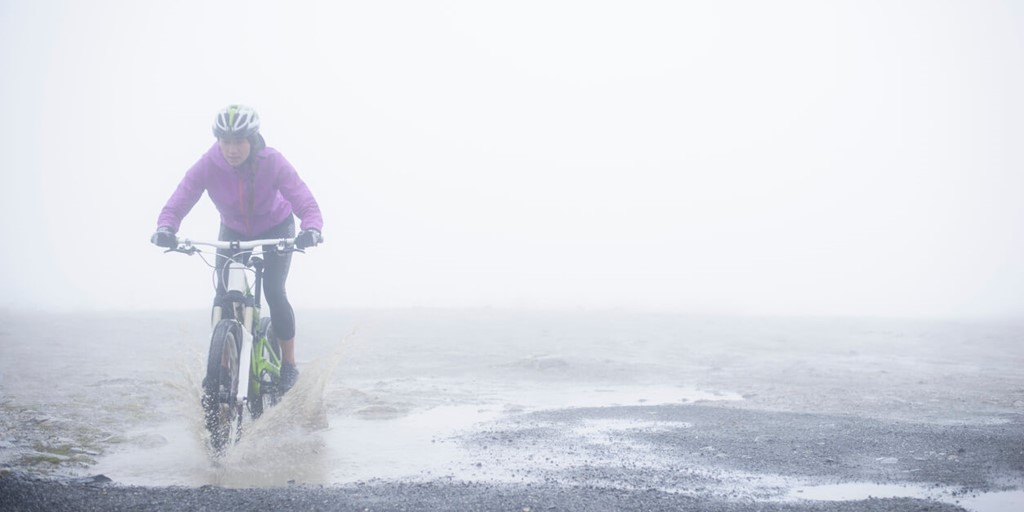Lizzie Deignan’s Top Tips For Cycling In The Rain

Cycling in the rain is pretty much guaranteed at some point, especially if you live in the UK. Luckily, there are lots of ways to make the experience far more comfortable and safer.
We asked our ambassador Lizzie Deignan, Olympic silver medallist and former World road race champion, to give us her top tips for cycling in the rain.
Lizzie knows a thing or two about all-weather rides. In her words: “There’s no secret for cycling in wind and rain – you just have to grin and bear it. Growing up in Yorkshire, I’ve had to grin and bear my fair share!”
So, from drizzles to downpours, we’ve got you covered. Read on for our expert advice.
Table of contents
1. Wear waterproof clothing
2. Attach mudguards
3. Avoid standing water
4. Check your tyres
5. Attach lights and reflective gear
6. Insurance
1. Wear waterproof clothing
You probably already have this covered, but it’s a tip worth repeating!
For heavy or persistent rain, you need a waterproof jacket, overshoes, and gloves with maximum water resistance to help you battle the elements.
Remember, your waterproof gear doesn’t just need to repel rain, it needs to be breathable, too. Breathability means the heat from your body (that you’ll generate throughout the ride) can easily escape. Cheaper fabrics will act as a greenhouse, causing you to sweat more and allowing moisture to accumulate underneath that layer.
Gore-Tex is the best material for cycling in the rain as it’s both waterproof and breathable. We recently wrote an article on the best waterproof cycling jackets, which you can read here.
Vented helmets are great when the weather’s warm and dry, but they don’t offer much protection if you’re cycling in the rain. That’s why you need a cycling cap under your helmet to protect your head and hair. The cap’s peak will also provide extra protection for your eyes against pouring rain.
Lizzie Deignan says:
“Wearing the right clothing is the key to an enjoyable ride when the weather isn’t looking good. As the old saying goes, ‘There’s no such thing as bad weather, just bad kit’, and it really does make a difference.
“Whilst it’s important to keep yourself dry, it’s also vital to strike a balance between keeping the rain off and letting your body breathe – so pick appropriate gear for the temperature and ensure you have breathable fabrics.
“Santini has a great range to choose from, and they look good too. If it’s winter and freezing, something like the Santini Vega Extreme Women’s Jacket would be ideal. If it’s summer rain and a warmer air temperature, then the Guard Nimbus Women’s Packable Rain Jacket is a perfect choice.
“Other accessories like gloves, warm socks, and overshoes will also keep you even warmer. I also always wear a neck warmer in winter. If the weather is changeable, then think about layers so you can take them off as you warm up and put them on again if you stop for a coffee!”
2. Attach mudguards
Ok, they might not always be the most fashionable cycling accessory. But, when it comes to cycling in the rain, mudguards are vital.
Without mudguards, you risk permanently staining jerseys and jackets with oil, mud, and other substances. Even if you manage to miss the rain before your ride, the roads will remain wet – so make sure you invest in a pair.
Lizzie agrees:
“Fitting mudguards to your wheels will protect you from puddles and surface water on the roads when you’re out in bad weather. It will protect your cycling buddies behind you from getting unwanted rain and mud on their face, and your clothing will thank you.”
3. Avoid standing water
Riding through standing water not only gets you wetter but can also be extremely dangerous. You never know what’s beneath the surface; it might just look like an innocuous puddle, but it could be hiding a bike-damaging pothole. You should only ride through standing water if you can clearly see what’s beneath it.
Most standing water will gather near the kerb, so check over your shoulder for vehicles before moving away from the kerb to avoid the area.
Try and avoid any rainbow-edged patches on the street, too – they can be a strong indication of an oil patch. Also, keep an eye out for other surfaces that are slippery when wet, such as manhole covers and damp leaves.
Lizzie says:
“It’s really important to take extra care in the wet conditions, especially when you are going downhill or crossing white lines on the road, as these will be smoother and more slippery than other parts of the tarmac.
“Be disciplined in checking your brakes, too. The wetter the road surface, the longer it will take you to come to a stop when you squeeze your brakes, so be alert and give yourself as much time as possible.
“As well as avoiding standing water, don’t be afraid to own the road. Move out if necessary, just as long as you make cars aware and motorists can see you.
“In inclement weather, stick to flat, sheltered roads where possible, rather than venturing off into hilly terrain with potentially treacherous descents.”
4. Check your tyres
When you’re cycling in the rain, tyre grip becomes more important than ever. After each ride, you should check your tyres for any flints, glass, or other debris. The wet weather makes it easier for these materials to damage your tyres.
It’s also a good idea to ride the heavier tyre in the winter with a thick tread, as this will give you more grip for both wet and icy surfaces. A 25 – 28c tyre with a slightly lower pressure should give you the grip you need, even in the worst of conditions. There are some great tips for preparing your bike for wet weather in this article.
Lizzie says:
“Tyres can be a personal choice in terms of what feels comfortable. However, in bad weather, grip is what you’re looking for – so letting a little pressure out of your tyres is a good idea. By reducing the tyre pressure, you are increasing the contact patch of the tyre on the road surface, giving you better grip.
“No-one wants to be hanging out in the cold fixing a puncture on the side of the road – so check your tyres regularly for grit and dirt. This form of build-up can cause unwanted punctures when out on a ride.”
5. Attach lights and reflective gear
Visibility will naturally decrease during a downpour, so reflectors and lights that make you as noticeable as possible are paramount. One of the most common causes of cycling accidents is a motorist failing to see a cyclist while turning or changing lanes – so this tip is especially important.
There are plenty of options out there – from reflectors to high-vis wearables of all kinds and powered lights.
We wrote at length about the most essential bike safety gear, with a detailed section on lights. Check out our article here.
Lizzie says:
“It’s obvious that lights are needed if you are riding in the dark, and more people are using them in the day now. Front lights and back lights are a good idea, as they make you way more visible, and that’s got to be a good thing. If it’s a bit foggy or the conditions are bad, you need to be seen by all road users. It’s worth spending a little to get decent visible ones too, like the ones from Bontrager.”
6. Insurance
Following the above tips will keep you as safe and dry as possible. However, things can still go wrong when cycling in the rain – even for the most experienced rider.
It’s not worth getting on the saddle without robust insurance, whatever the circumstances. Insuring yourself, your bike and your accessories frees you from worry every time you ride, whatever rainy, oily, or muddy situation you might find yourself in.
Lizzie says:
“Cycling is such an enjoyable activity. But, like anything, it has its dangers. Therefore, as cyclists, we need to protect ourselves in as many ways as we can, which includes getting insurance. Cycleplan can protect you, your bike, and other road users so that you can ride with added peace of mind.”
Taking out a policy from Cycleplan means the only thing you’ll have to think about is enjoying yourself. You can build your own bespoke cover right here.
Related
The 7 Best Waterproof Jackets For Men
What To Wear When Cycling In Cold Weather
The Most Essential Bike Safety Gear For Your Next Ride






